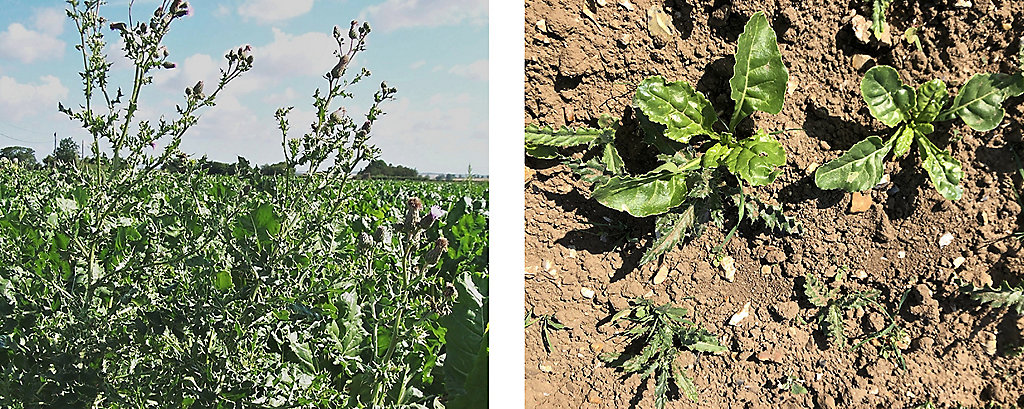Thistles are highly competitive weeds in sugar beet, often resulting in yield loss and harvesting difficulties where infestations are high.
Thistles in sugar beet


Creeping thistle
The most widespread and damaging of thistle species in sugar beet crops are creeping thistles (Cirsium arvense). They are a highly competitive, perennial weed and an infestation of a single thistle stem per square metre can cause yield losses of up to one tonne per hectare. Capable of growing up to 90cm in height, reproduction occurs via creeping lateral roots that are capable of overwintering. Typically, the roots reach a depth of 1-2 metres, but can reach a depth of up to 5 metres in well aerated soils. The specialised root system is the reason why creeping thistles are able to survive indefinitely, because much of their root systems exist below typical cultivation depth.
Even root fragments of 12.5 cm or smaller are capable of giving rise to new infestations, which is why field cultivation often results in increasing infestation, as new shoots arise from root buds. As temperatures rise above 50c in the spring, overwintered roots produce aerial shoots that develop into distinct patches of creeping thistle, colonising at a rate of up to 6 m per annum.
Seed dispersal is another method by which new infestations can arise. In contrast with other Cirsium species, creeping thistles have male and female flowers on separate plants. Consequently, there is a high degree of cross pollination which ensures genetic diversity in the species. Seeds are produced from July to September and are usually shed from August onwards. Commonly, each plant typically produces 1500 seeds per plant, but as many as 5000 seeds has been recorded.
Researchers have long questioned the significance of seed as the main dispersal method for creeping thistles. It is often thought that irrigation water may play a role in long distance dispersal. Usually, the seed will germinate within a matter of days, particularly in warm conditions. Alternatively, seed may remain dormant in the soil for up to 6 months in water and 21 years if buried at depth in soil.
Cultural techniques for control of creeping thistles, include deep ploughing, shallow cultivation, repeated mowing, smothering with straw and even burning. Current opinion suggested no single method is likely to give complete control.
Starving of roots by ploughing and mowing, coupled with a herbicide strategy that weakens top growth and reduces the root bud bank, is now viewed as the most successful strategy.
Annual thistles
Annual thistles (Prickly / Sow thistles) are less of problem in sugar beet, but when they exist in high populations, can produce dense stands of tall stems which can slow the progress of harvest considerably. Both plants produce yellow flowers in early summer and can produce 5000 – 6000 seeds per plant, depending on the species.
Chemical control of thistles
Both creeping thistles and annual thistles can be effectively controlled using Shield Pro™ (formerly known as Dow Shield® 400). If targeting Sow Thistles, apply Shield Pro at 0.5l/ha when the weeds are small, up to 2 true leaves.
For optimum control of creeping thistles a sequential approach should be adopted. First apply Shield Pro at 0.25l/ha in 200/250 litres of water when the weeds are at the rosette stage. Follow up with a second application of 0.5l/ha again in the same water volume three to four weeks later.
Shield Pro may also be applied as part of a sequential low dose program. A rate of 0.25 litres per hectare in 80 to 100 litres of water should be applied with the following partners.
Partner |
Minimum Crop Size |
Notes |
Ethofumesate |
Two full expanded true leaves |
Improves control of creeping thistle and mayweed up to 4 expanded true leaves. Do not use on red beet |
Metamitron + oil |
First true leaves at least 10cm long |
Improves control of thistles and black bindweed. |
Shield Pro can be included once in at any stage of the program, provided all products are used in accordance with manufacturers’ instructions.
To achieve maximum control of creeping thistle a second application of Shield Pro, alone at 0.5l/ha in 200-250 litres of water, should be made up to 3-4 weeks later.
Additional resources:
Distribution and biology of creeping thistle in the UK - AHDB link
